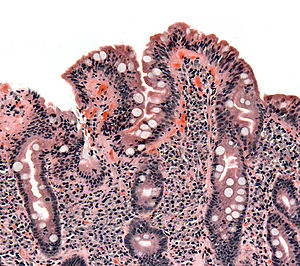โรคของซีลิแอ็ก
จากวิกิพีเดีย สารานุกรมเสรี
โรคของซีลิแอ็ก[19] (อังกฤษ: coeliac disease หรือ celiac disease) เป็นโรคภูมิต้านตนเองระยะยาวซึ่งสร้างปัญหาโดยหลักต่อลำไส้เล็ก[14] อาการตามแบบรวมทั้งปัญหากระเพาะลำไส้ เช่น ท้องร่วงเรื้อรัง ท้องพอง/ท้องยื่น (abdominal distention) ดูดซึมอาหารไม่ดี (malabsorption) ไม่อยากอาหาร และไม่โต (ในเด็ก)[5] ปกติจะเกิดเมื่ออายุระหว่าง 6 เดือนถึง 2 ขวบ[5] แต่อาการอื่น ๆ จะสามัญกว่าโดยเฉพาะในผู้มีอายุมากกว่า 2 ปี[12][20][21][22] อาการกระเพาะลำไส้อาจจะเบาหรือไม่มี อาจมีอาการที่ส่วนอื่น ๆ ของร่างกาย หรือไม่ปรากฏอาการอะไร ๆ เลย[5] แม้โรคอาจเริ่มตั้งแต่วัยเด็ก[10][12] แต่ก็เกิดเมื่ออายุเท่าไรก็ได้[5][12] โรคมักสัมพันธ์กับโรคภูมิต้านตนเองอื่น ๆ เช่น โรคเบาหวานประเภทที่ 1 และต่อมไทรอยด์อักเสบเป็นต้น[10]
| โรคของซีลิแอ็ก (Coeliac disease) | |
|---|---|
| ชื่ออื่น | Celiac sprue, nontropical sprue, endemic sprue, gluten enteropathy |
 | |
| เนื้อที่ตัดจากลำไส้เล็กออกตรวจ แสดงลักษณะของ coeliac disease คือมีส่วนยื่นที่ทื่อลง (blunting of villi) ส่วนม้วนเข้าที่ใหญ่เกิน (crypt hypertrophy) และลิมโฟไซต์เข้าไปในส่วนม้วนเข้า (lymphocyte infiltration of crypt) | |
| การออกเสียง |
|
| สาขาวิชา | วิทยาทางเดินอาหาร อายุรศาสตร์ |
| อาการ | ไม่มีหรือไม่เจำเพาะ, ท้องยื่น/ท้องพอง, ท้องร่วง, ท้องผูก, ดูดซึมอาหารไม่ดี, น้ำหนักลด, dermatitis herpetiformis[A][5][6] |
| ภาวะแทรกซ้อน | ภาวะเลือดจางเหตุขาดธาตุเหล็ก ภาวะกระดูกพรุน เป็นหมัน มะเร็งต่าง ๆ ปัญหาทางประสาท และโรคภูมิต้านตนเองอื่น ๆ[7][8][9][10][11] |
| การตั้งต้น | ไม่จำกัดอายุ[5][12] |
| ระยะดำเนินโรค | เป็นตลอดชีวิต[10] |
| สาเหตุ | ปฏิกิริยาต่อกลูเตน[13] |
| วิธีวินิจฉัย | สอบประวัติครอบครัว ตรวจสารภูมิต้านทานในเลือด ตัดเนื้อลำไส้ออกตรวจ ตรวจพันธุกรรม ดูการตอบสนองเมื่องดกลูเตน[14][15] |
| โรคอื่นที่คล้ายกัน | ลำไส้อักเสบ พยาธิลำไส้ กลุ่มอาการลำไส้ไวเกินต่อการกระตุ้น ซิสติกไฟโบรซิส[16] |
| การรักษา | อาหารปลอดกลูเตน[17] |
| ความชุก | ~1 คนใน 135 คน[18] |
โรคเกิดจากปฏิกิริยาของร่างกายต่อกลูเตน ซึ่งเป็นโปรตีนต่าง ๆ ที่พบในข้าวสาลีและข้าวประเภทอื่น ๆ รวมทั้งข้าวบาร์เลย์และข้าวไรย์[13][23][24] ปกติคนไข้สามารถรับข้าวโอ๊ตที่ไม่มากเกินโดยไม่เจือปนกับข้าวที่มีกลูเตนอื่น ๆ ได้[23][25] แต่ก็อาจมีปัญหากับข้าวโอ๊ตบางสายพันธุ์[23][26] เป็นโรคที่เกิดกับผู้มีปัญหาทางพันธุกรรม[14] คือ เมื่อได้รับกลูเตน การตอบสนองผิดปกติของระบบภูมิคุ้มกันจะผลิตสารภูมิต้านทานต้านตนเอง (autoantibody) ซึ่งอาจสร้างปัญหาแก่อวัยวะต่าง ๆ[8][27] ในลำไส้เล็ก นี่ทำให้อักเสบ และอาจทำส่วนยื่นที่บุลำไส้ (intestinal villus) ให้สั้น/ทื่อลง เป็นอาการที่เรียกว่า villous atrophy[14][15] ซึ่งทำให้ดูดซึมอาหารได้น้อยลง และบ่อยครั้งทำให้โลหิตจาง[14][24]
การวินิจฉัยจะอาศัยการตรวจสารภูมิต้านทานในเลือดบวกกับการตัดเนื้อลำไส้ออกตรวจ โดยการทดสอบทางพันธุกรรม (genetic testing) โดยเฉพาะอาจช่วย[14] แต่บางครั้งก็วินิจฉัยได้ยาก[28] เพราะอาจตรวจไม่พบสารภูมิต้านทานต้านตนเอง (autoantibody)[29][30] เพราะลำไส้เล็กอาจเปลี่ยนไปเพียงเล็กน้อยและส่วนยื่นจะดูปกติ[21][31] แม้ผู้ที่มีอาการหนักก็อาจต้องไปหาหมอเป็นเวลาหลายปีกว่าจะวินิจฉัยได้ถูกต้อง[32] ปัจจุบันมีผู้ไม่มีอาการอะไร ๆ ที่วินิจฉัยว่ามีโรคนี้ โดยอาศัยการตรวจคัดโรค[33] แต่หลักฐานซึ่งแสดงประโยชน์ของการตรวจคัดโรคก็ยังไม่ชัดเจน[34] แม้โรคจะมีเหตุจากความไม่ทนต่อโปรตีนข้าวสาลี แต่นี่ก็ไม่ใช่ภาวะภูมิแพ้ข้าวสาลี (wheat allergy)[14]
วิธีการรักษาในปัจจุบันอย่างเดียวก็คือการให้ทานอาหารปลอดกลูเตนตลอดชีวิต ซึ่งอาจทำให้เยื่อลำไส้ฟื้นตัว ทำให้อาการดีขึ้น และลดความเสี่ยงภาวะแทรกซ้อนอื่น ๆ ซึ่งได้ผลต่อคนไข้โดยมาก[17] ถ้าไม่รักษา นี่อาจทำให้เกิดมะเร็ง เช่น มะเร็งต่อมน้ำเหลืองของลำไส้ (intestinal lymphoma) และเพิ่มความเสี่ยงการตายก่อนวัยโดยเล็กน้อย[7] อัตราการเกิดโรคไม่เหมือนกันในเขตต่าง ๆ ทั่วโลก เริ่มจากความชุกโรคที่ 1 คนต่อ 300 คนจนถึง 1 คนต่อ 40 คน โดยเฉลี่ยที่ระหว่าง 1 คนต่อ 100 คน กับ 1 คนใน 170 คน[18] ในประเทศพัฒนาแล้ว ประเมินว่า คนไข้ 80% ยังไม่ได้วินิจฉัย เพราะมีปัญหากระเพาะลำไส้น้อยมากหรือไม่มีเลย และเพราะไม่รู้เรื่องโรค[9][35] เป็นโรคที่สามัญในหญิงมากกว่าชาย[36] คำภาษาอังกฤษว่า coeliac มาจากคำภาษากรีกว่า κοιλιακός (koiliakós, "abdominal" แปลว่า เกี่ยวกับท้อง) โดยเริ่มใช้ตั้งแต่คริสต์ศตวรรษที่ 19 อาศัยงานแปลจากภาษากรีกโบราณเกี่ยวกับโรคของแพทย์ชาวกรีกคือ Aretaeus of Cappadocia[37][38]
เชิงอรรถ
อ้างอิง
แหล่งข้อมูลอื่น
Wikiwand - on
Seamless Wikipedia browsing. On steroids.
